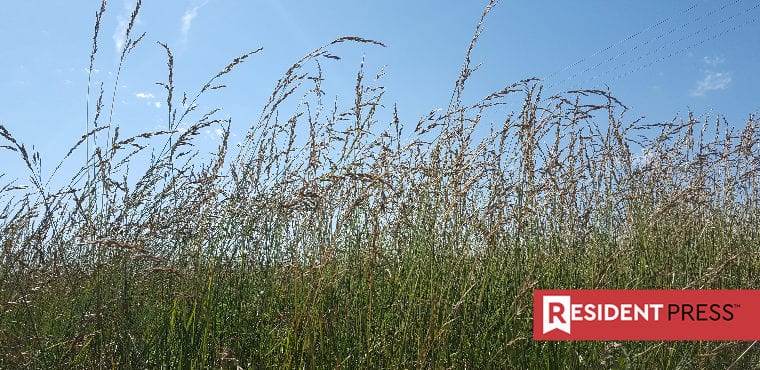By Mary Hightower
U of A System Division of Agriculture
Arkansas livestock producers may be getting a little worried as their forage and hay pastures turn thirsty and rainfall is more random and scattered.
While Arkansas saw a very wet April, the May 30 Drought Center map showed nearly 42 percent of the state as being abnormally dry.
Justin Condry, meteorologist for the National Weather Service at Little Rock, said Monday that an emerging El Niño will mean the return of a more typical summer weather pattern for Arkansas.
“We’re going to see a lot of pop-up showers in the afternoon,” he said. “It’s that kind of thing where your neighbor down the road could pick something that you may not.”
A pattern of dry weather has set in, causing ranchers concern about their hay meadows and pastures. File photos.
Condry said the summer outlook from the Climate Prediction Center covering June, July and August projects “slightly above-average temperatures and slightly above-average rainfall.”
However, Condry cautioned that the three-month outlook is generalized and that not everyone will see above-average rainfall through the summer.
Smaller hay cuttings
Cody Burkham, executive vice president of the Arkansas Cattlemen’s Association, said he hasn’t heard of anyone resorting to hay for forage yet, he reports some cuttings in north central Arkansas are a “quarter to a third below average.”
The National Agricultural Statistics Service report on Monday showed 13 percent of non-alfafa hay in poor condition, with 11 percent of pastures in poor or very poor condition.
“We are becoming very concerned about the dry conditions in Van Buren County,” Danny Griffin, county extension staff chair for the University of Arkansas System Division of Agriculture, said Monday. “Most producers who fertilized early have made an average hay crop, but many are concerned about making a second harvest or having to feed the first due to lack of rain on pastures.
“Our soils dry out quickly,” Griffin said. “The old timers used to say that ‘we are always two weeks from a drought at any time’.”
Prussic acid
The drought brings an additional grazing concern, he said.
“I have been on the phone this morning with a producer concerned about grazing sorghum-sudangrass that he planted and fertilized,” Griffin said. “It can accumulate nitrates and prussic acid in drought conditions and become toxic to grazing animals.”
In Jackson County, which includes parts of the eastern Ozarks, “Hills are drying up fast from what I saw last week,” said Matthew Davis, Jackson County extension staff chair. “Many water holes are dry and any non-diverse forage areas are struggling. The higher up on the Ozarks you go the worse it is because of the shallow soil.”
Davis also said that “grazing rotations are being impacted by lack of water in places, and non-irrigated hay ground won’t be cut anytime soon because grass isn’t growing off.”
Back to forage management basics
Maggie Justice, assistant professor and extension beef cattle specialist, said now is not the time to forget basic forage management.
- Water — “Make sure your animals have access to good clean water. Make sure to monitor natural water sources more closely during drier times,” she said.
- Monitor your pastures — “Be more aware of toxic plants in your pastures,” Justice said. “Cattle grazing short pastures are more likely to consume toxic plants.”
Justice also said producers shouldn’t let cattle graze too long on short pastures, since it will make it more difficult for grass to recover.
“Let the grass grow back before grazing,” she said. “Concentrate cattle in a ‘sacrifice’ area if needed. Close the gates and give your remaining forage a chance.”
“Start thinking about long-term management decisions such as animals that might need to be culled,” Justice said. “Consider culling open cows, old and low producers in the herd. This will provide more feed for the younger and more productive cows.”
“If you have to start feeding hay due to lack of forage — don’t waste the hay!” she said. “Use recommended methods for properly feeding hay such as feeders that minimize waste, unrolling hay, and limiting the time cows have access to hay each day if needed.”
Find information on prussic acid and cattle and managing cattle in drought online and at your county Cooperative Extension Service office.
To learn about extension programs in Arkansas, contact your local Cooperative Extension Service agent or visit www.uaex.uada.edu. Follow us on Twitter and Instagram at @AR_Extension. To learn more about Division of Agriculture research, visit the Arkansas Agricultural Experiment Station website: https://aaes.uada.edu/. Follow us on Twitter at @ArkAgResearch. To learn more about the Division of Agriculture, visit https://uada.edu/. Follow us on Twitter at @AgInArk.







